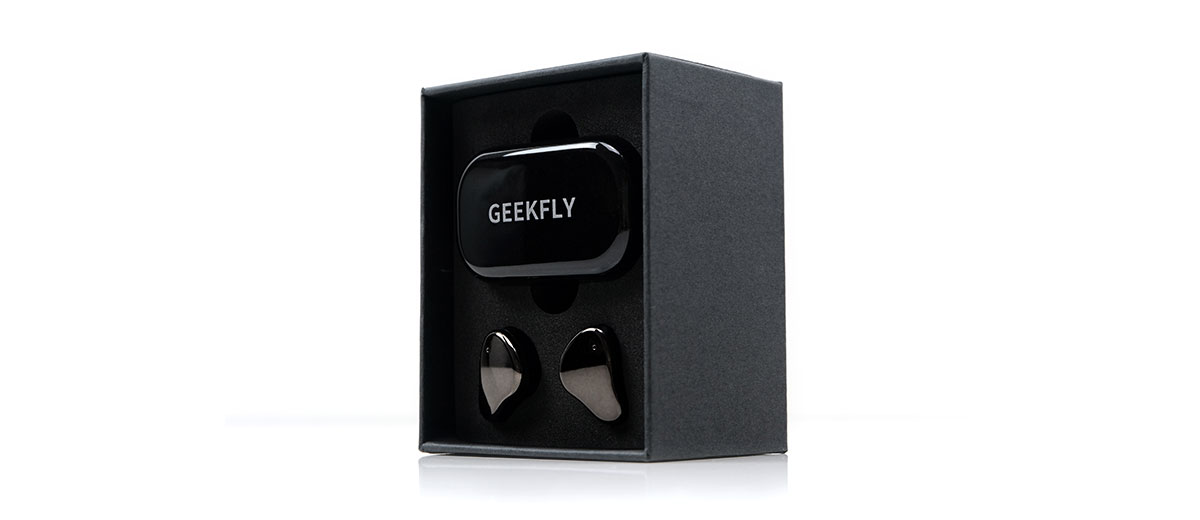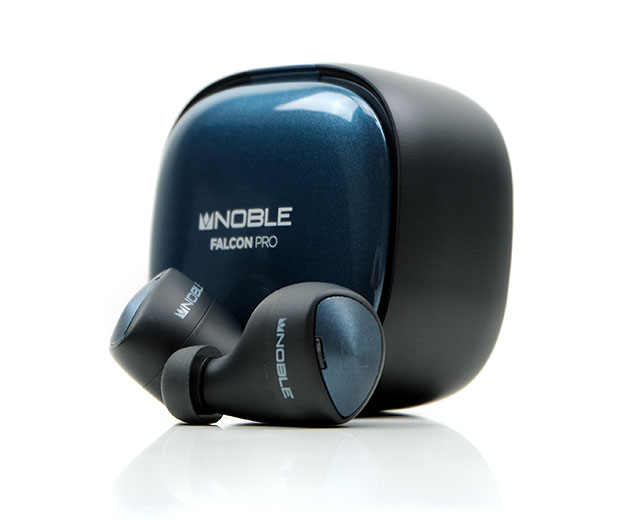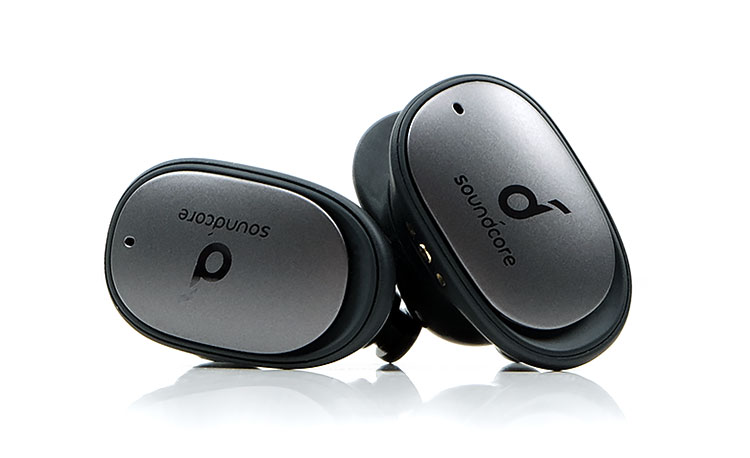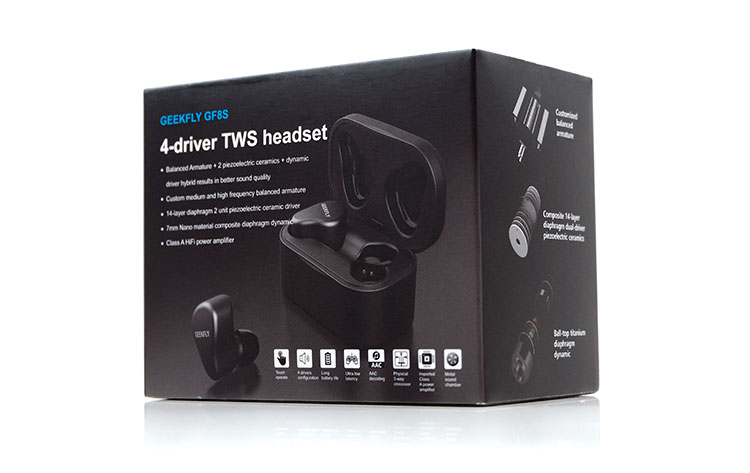Wireless Performance
Pairing
The GF8s does not use a master-slave type of connection process, both drivers can operate independently of each other. Pairing is really easy with a single label shown in the scan from any receiver “GEEKFLY GF8s”.
There are no left or right options to pick from so both will connect to each other and device quickly for stereo playback. This remained true for 2 smartphones and 1 laptop tested in the review process. For reference, that is an Asus Rog Phone 3 on Android 11, Huawei P20 on Android 10, and an Acer Nitro 5 Windows 10 laptop.
Stability & Range
The stability and range using the GF8s with the Asus Rog Phone 3 was stellar with one of the longest ranges I have achieved yet with a TWS at around 14m and 2 walls.
The Huawei P20 and the Window’s laptop BT connections came up a little bit shorter with about 10-11m and couldn’t get past the 2nd wall. Any limits here will be dictated somewhat by the ability of your source BT device’s range but safe to say the SBC level decoding of the GF8s has its advantages if you need a bit of range.
Latency
There is some latency for media to voice syncing, especially noticeable on streaming content such as YouTube and Netflix using Windows 10.
Using VLC with a media file with a 162kbps bitrate and 48k sample rated audio track there was also some lag which you can correct with 0.2s or 0.3s of hastening synchronization. That’s a bit on the loose end for me compared to the likes of the Falcon Pro but not out of sync with some other competing TWS such as the Liberty Pro 2, (albeit using aptX Classic).
Select Comparisons
Noble Audio Falcon Pro
$329
Technical
Our current top dog in the TWS sector for the year and like the GF8s this is also a multi-driver design. however, the Falcon Pro does not use a triple hybrid but uses a single 6mm tri-layered titanium-coated dynamic driver (TLT) and the latest generation “SRDD” Knowles dual BA driver. The split is the DD for the lows and mids, and the dual BA for the highs.
The GF8S goes one driver further with a titanium-coated dynamic driver, slightly larger at 7mm but only one BA for the mid-highs and dual piezoelectric for the ultra-highs with a 4-way configuration. It also has that Class A amp which is just superb in powering all 4 drivers.
Both have independent driver pairing technology with the Falcon supporting legacy Qualcomm TrueWireless™ Stereo and TrueWireless Mirroring modes. Geekfly does not state their formal technology for this rather simple “not main secondary’ which is an awkward way of saying the same thing.
Things that the Falcon Pro does have that the GF8s does not include aptX decoding ability which is a big plus, an IPX5 rating, and a good quality app with EQ and ambient sound modes.
In terms of battery life, the Falcon Pro is much stronger here at 11 hours compared to just 5 on the GF8s. A caveat, the Falcon Pro can drop to almost 5 hours also at full volume but how many play at full volume? I would say not many.
The cradle batter on the Pro is up to 28 hours compared to the GF8s on 20 hours so both have about 4 cycles in them but that additional longer battery cycle of the Pro means you are less likely to need it during the day.
Design
The driver designs are very different. The Falcon Pro is much taller with that signature Noble long nozzle whereas the GF8s is a lot flatter and wider with a very short nozzle. The GF8s looks like an IEM, the Noble looks like a typical TWS if that makes sense.
Definitely, the Falcon Pro is the better TWS for passive isolation with that longer nozzle whereas the GF8s is the comfier and lighter of the two in the ear.
I do appreciate the engineering on the Falcon Pro, it has a more interesting contrast in its color scheme, whereas the GF8s looks very understated in its all black. Both are mainly plastic builds.
Both have touch-sensitive faceplates though the curving on the Falcon Pro design means there is less of a chance of accidentally touching them when slotting them in and out of your ear or cradle. The GF8s has a wider area, a bit more lag also and you cannot customize the controls via any app which the Noble Sound Suite can offer.
Both have really compact cradles, in fact, the GF8s is even more pocket-friendly. However, the Falcon Pro cradle does feel a bit more premium and they are less slippery to get out compared to the GF8s. Both have USB-C charging capability but neither have wireless or quick-charge capability.
Performance
Both of these TWS have V-shaped signatures for the most part with some slight variation in the forwardness of the upper mids. However, the big differentiator for me is the amplitude of that tweeter in the Falcon Pro which is much further forward bringing with it a lot of treble presence and odd harmonic coloration into the upper mids.
That means the Pro is a dynamic but very high contrast sound with a harder edge to notes in that region and generally a cooler instrumental and vocal timbre.
For the most part, the GF8s also delivers an accentuated sub-bass and dipped lower-mids up to 1k, as well as a forward 1-4 region. However, unlike the Falcon, its BA is not being used as a tweeter so it’s nowhere near as pushed except for a secondary 7-8k peak which is much lower than its 1-4k rise.
That creates a slightly darker tone compared to the Falcon Pro but also a smoother richer texture to its timbre with a liquid attack and basically more power at its lowest point. This is definitely a more even-harmonic planted sound from the bass up into the mids.
What the Pro has though is a more vibrant vocal delivery with more space and air in the mids through to the treble. The GF8s sounds a little bit more laid back here with less air but a broader note and a bit more texture to its vocal performance.
I think the Falcon Pro has the edge on the technical side with its aptX decoding but the timbral bias of the GF8s delivers a much smoother listening experience as well as having the best sub-bass tuning of the two for pure power.
Anker Soundcore Liberty 2 Pro
$149.99
Technical
We reviewed the Liberty 2 Pro around a year ago or July 2020 and at the time it was also one of those rare beasts, a multi-driver TWS. Inside, the Pro 2 uses a mix of a large single 11mm dynamic driver for the lows and mids and a single BA covering the upper mids and highs in what Anker calls an Astria Coaxial Acoustic Architecture.
The GF8s is more adventurous, more bleeding edge with its 5-way quad driver mix of a dynamic driver, a single BA, and dual piezoelectric for the ultra-highs.
The dynamic driver is smaller though at 7mm compared to 11mm and they do seem to cover the same lows and mids FR. However, the piezoelectric drivers will offer a bit more headroom and extension with the BA relaxing a little compared to the work required from the Pro 2 single BA.
The Pro 2 is also lacking that Class internal amplifier with an onboard SoC amplifier doing most of the grunt work.
Both offer BT5.0 protocols but here the Pro 2 edges ahead in decoding with aptX capability compared to just AAC and SBC for the GF8s. The Pro 2 also has an IPX4 rating and an excellent Android app with multiple EQ profiles which the GF8s lacks.
The Pro 2 has an edge for battery life at 8 hours per driver and 24 hours in the cradle as well as wireless Q charging compatibility. The GF8s will take longer to charge, has a shorter 5-hour battery life in the driver, and just 20 in the cradle tank with no wireless charging capability.
Design
This is where the GF8s has some advantages. Now I love the sliding roof deck design of the Pro 2 cradle and generally speaking its pebble form factor is lower profile and very easy to work with. On that count, the Pro 2 has the edge over the cheaper GF8s cradle.
However, on the drivers, the Pro 2’s are much bigger and bulkier and do require stabilizing ear wings to staying place. The GF8s drivers are smaller, lighter, sit flush in your ear, and isolate just as well. They look like a pair of IEMs whereas the Pro 2 combo looks more like how you would expect a TWS to look like these days.
Now I am agnostic on this but the use of touch on the GF8s versus the use of mechanical buttons on the Pro 2 do have pros and cons. You will not hit the buttons by accident on the Pro 2 quite like the GF8s but they are tiny and not as easy to find when in your ear. However, you can customize the buttons via the Soundcore app, something which I wish the GF8s had.
Performance
Like the Falcon Pro, the Livery Pro 2 has a very high contrast type of tone with a v-shaped FR that is almost bucket-shaped through the upper bass around 200Hz to around 1k before it starts to rise again.
Both have a strong sub-bass response but the GF8s drop into the lower mids is a bit more gradual bringing some more warmth and it’s not as flat through the same range either. Notes sound plumper, the timbre richer, and the attack more liquid or smoother.
The Pro timbre is light, high contrast, and much thinner through the mids as well as picking up an energetic treble tuning that kicks back a little bit of edginess into the upper mids. The resulting vocal tone is thus cool and light with a typical BA timbre, clean and precise.
The GF8s mids have more body, vocals sound smoother with treble a lot more controlled. Geekfly has not used the single BA to push hard on the treble but instead left it to the piezoelectric to continue the extension and that works in its favor in terms of a lack of sibilance and edginess.
You could argue that the GF8s is the softer darker of the two because of that dip from 5-7k and it does suck a little air out as a result. The Pro 2 might be the airier of the two around the same region but its timbre can be more fatiguing.
HiBy WH3
$159
Technical
The WH3 was launched in the 3rd quarter of last year and is also a multi-driver TWS but with a bit of a twist. Inside, the driver configuration is not as complex as the GF8s with a single polymer diaphragm dynamic driver for the lows and mids and a single BA for the highs.
The GF8s is much more ambitious with its 5-way 4-driver single dynamic, BA, and dual piezoelectric driver configuration including that Class A amplifier.
However, here is the interesting thing about the WH3 setup. The crossover is a user-adjustable digital creation that gives you a degree of control on exactly where you want that crossover to be via their HiBy Blue app.
They can do that because of the driver setup with a 4-way DAC and amplifier design to allow you to selectively switch between pure dynamic or pure BA or a mix of both. So that means you can get creative with your sound signature placing choice on the side of the WH3 whereas the GF8s is banking on a single sound signature of perceived higher quality.
The ironic thing is the original GF8 had this very ability to switch driver combos digitally with 4 drivers also but Geekfly did away with it with the new GF8s.
Other key points include the ability for the WH3 to decode up to aptX and even 24BIT/96Khz via their own UAT technology whereas the GF8s are purely SBC and ACC. Both use BT5.0 and have independent driver technology.
For battery life, the WH3 can Q wireless charge, and hold up to 24 hours in the cradle. Both drivers are rated for around 5 hours though the GF8s is slightly less for the cradle at 20 hours.
Design
Very different design philosophies here with HiBy going for the long stem “Apple Airpod Pro” form factor in white and the GF8s doing a classic IEM shape in black.
Both have pros and cons with the secure fit being one of them for the WH3 and the lower profile being the GF8s stronger trait. I know some just feel dorky with those stems so the GH8s design has its attractions.
Both isolate more or less the same with reasonable but not hugely long nozzles and single bore tip selections. Both TWSs use a touch-based system but the WH3 touch area is smaller and more center focused compared to the wider less defined area on the GF8s.
Some might prefer that for handling with the WH3 touch zone less likely to be prone to accidental touching. You can tweak the touch controls and upgrade the firmware via the HiBy Blue app which is quite feature-rich compared to the GF8s static feature set.
The WH3 cradle is a little bit bigger, holds 4 hours more juice than the GF8s compact case. The matte white design of the WH3 cradle is more refined but it is relatively plasticky also. Both have a USB-C charging port but HiBy chuck in additional Q wireless charging which the GF8s does not have.
Performance
We compared the GF8s to the hybrid crossover mode of the WH3 which I find to be the best performer of the three profiles available.
Of the three compared TWS, the WH3 has perhaps the most balanced presentation. There is a slight bass emphasis and some treble contrast but it is not as extreme as with the Liberty Pro 2 or the Falcon Pro.
No doubt the GF8s dynamic driver is more powerful, with a greater sub-bass emphasis and a little bit more warmth creeping into the mids. It is the more relaxed of the two for treble around the 5-7k region where it dips comparatively more.
Both vocals do have a bit of presence with the WH3 perhaps slightly clearer and marginally further forward. However, vocals and instruments have a better body and sound smoother on the GF8s. The WH3 has more of that thinner BA timbre influence into the mids and highs which robs it of a bit of weight.
That also means percussion work sounds articulate on the WH3 but a bit light and tinny in tone and lacking in meat. The GF8s, on the other hand, sounds a lot more natural for percussion notes with much better texture.
Despite the lack of aptX, the GF8s sound the stronger of the two on the technical side with better layering, a deeper and wider soundstage, and an audibly better dynamic range. The WH3 has solid imaging within its soundstage but it sounds a lot narrower for me and less distinct on the low-end in terms of layering and slam.
Our Verdict
The Geekfly GF8s really is a powerful performer for a TWS with excellent PRaT, a smooth mids/vocals presence, and just enough sparkle up top to give higher pitching notes a gentle lift. This is not your typical high-contrast boom and splashy TWS tuning. It is much more natural in its delivery than that and it stands out all the more for that reason.
However, reviewing the GF8s reminds me a little of the review process of the Luxury & Precision P6. That compelling need to tell you how great it sounds compared to some of the competition and just hoping you will overlook some of the lacking features.
Features such as aptX, wireless charging, and some sort of app that is often demanded by crossover audiophiles would have made this the complete package. As such, LDAC is now creeping in that means less and less will want SBC levels of compression.
Thankfully, the excellent quad-driver configuration and Class A driver inside the GF8s lift it way above a lot of the aptX capable competition in terms of pure likeability. This is a compelling if somewhat of a dark horse of a TWS for audiophile purists.
Geekfly GF8s Specifications
- Bluetooth version: 5.0
- Charging interface: type-c
- Power input: DC5V/600mAh
- Headphone Battery capacity: 3.7V/70mAh
- Call/playtime: about 5 hours
- Charging compartment battery capacity: 3.7V/700mAh
- Supporting agreement: HSP1.2/HFP1.7/A2DP1.3/AVRCP1.6/SPP1.2/PBAP1.0
- Sensitivity: 106dB
- Frequency range: 20-50khz
- Impedance: 10Ω





